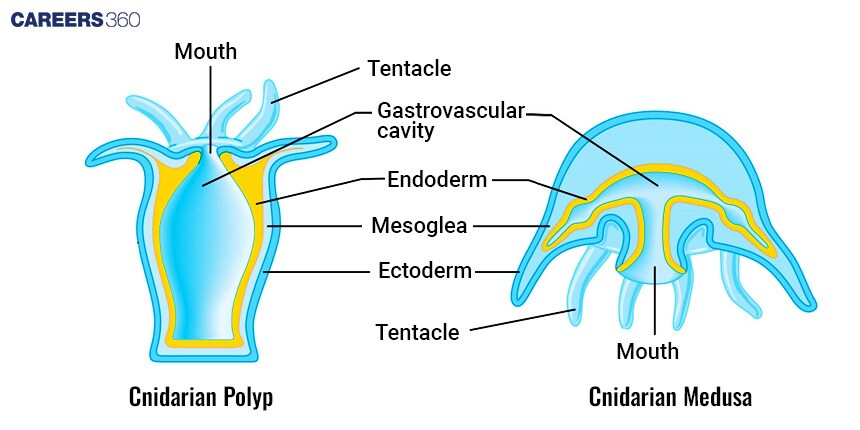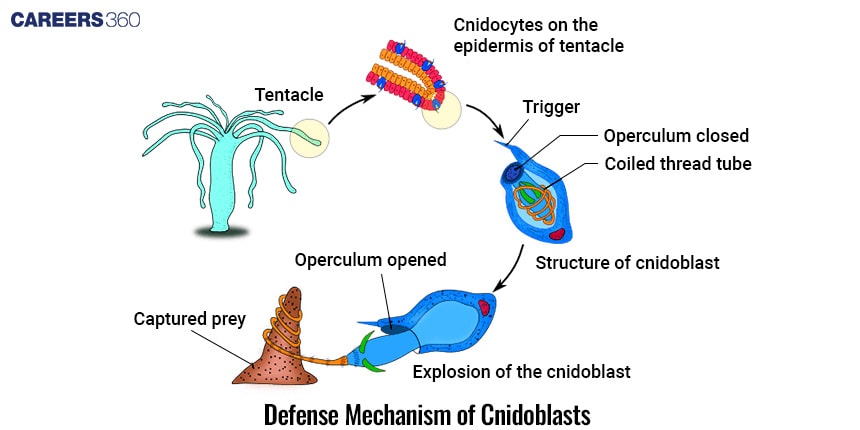Phylum Cnidaria: Meaning, Examples, Characteristics, Structure, Classification
What Is Phylum Cnidaria?
Phylum Cnidaria represents a whole group of aquatic animals that are characterised by unique stinging cells called cnidocytes. These creatures form a part of the marine ecosystem and contribute to viable biodiversity.
Taxonomy And Classification Of Cnidaria
Phylum Cnidaria includes a wide diversity of aquatic animals that are easily distinguishable through their possession of symmetrical, stinging cnidocytes used for the capture of prey and defence. The phylum includes the known species of jellyfish, corals, sea anemones, and hydras, all having a very simple body plan and radial symmetry.
Cnidarians are classified into four main classes:
Anthozoa
The anthozoans are entirely polypoid. They do not have a medusa stage in their life histories. They are also very diverse in form, ranging from solitary to colonial. They represent a quite complex style of gastrovascular cavity with numerous septae.
Examples: Corals, sea anemones, and sea pens.
Scyphozoa
Known as the true jellyfish, scyphozoans are primarily represented by the medusa form, which is normally large and conspicuous; they have a thick, gelatinous mesoglea and often exhibit pulsating movements for locomotion.
Examples: Aurelia, the moon jellyfish; and Cyanea, the lion's mane jellyfish.
Cubozoa
The medusa stage of cubozoans, more commonly known as box jellies, is cube-shaped. They have highly specialised eyes that can detect light and form images, and they are armed with a powerful venom.
Examples: Chironex fleckeri, the sea wasp; and Carukia barnesi, the Irukandji jellyfish.
Hydrozoa
Almost all hydrozoans are capable of switching from polyp to medusa and back again, although some are only polyps or medusae. Colonies of specialized polyps carrying out different functions are constructed by them.
Examples: Hydra
Diagram Of Different Types Of Cnidaria
The diagram below shows the polyp and medusa form of cnidaria.

Morphology And Anatomy Of Cnidaria
The cnidarians have two well-known body plans: the sessile polyp and the free-swimming medusa. The polyp is cylindrical, with a mouth surrounded by tentacles at the upper end, and it is normally attached to a substrate. The medusa, on the other hand, is umbrella-shaped, with tentacles hanging down from the edges. Both forms have a single central gastrovascular cavity functioning in digestion and the distribution of food, and a gelatinous layer, the mesoglea, which provides structural support.
Specialised structures include cnidocytes, unique cells for defence and capturing of food. Each cnidocyte contains a huge organelle called a nematocyst that carries a coiled, thread-like structure with a sting at the end that discharges toxins. When this mechanism paralyses its prey, other mechanisms allow ingestion, and digestive enzymes then complete the process of nutrient uptake. Although having a very simple body plan, cnidarians become effective predators.
Reproduction And Life Cycle
Cnidarians show asexual reproduction through budding and fragmentation. Budding refers to the growth of a new individual from the body of the existing one. Asexual reproduction a type in which a fragment of the organism separates to form a complete individual is called fragmentation. Such modes of asexual reproduction ensure rapid population growth and fast colonisation of new territories.
Cnidarians also reproduce sexually. The gamete formation that occurs involves the formation of both sperm and eggs, which are released into the water. Following external fertilisation, they undergo development, including a free-swimming larval stage, which is called a planula. The planula eventually settles out of the water column and metamorphoses into a sedentary form.
Feeding And Digestion In Cnidaria
Most cnidarians are carnivorous, and their tentacles have lines of cnidocytes that contain stinging structures called nematocysts. These extend harpoon-like threads that fire into the prey, paralysing or killing them immediately. In this way, cnidarians can capture a wide range, from minute plankton to larger food items, depending on the species.
Afterwards, the tentacles carry the immobilised prey to the mouth, opening into a gastrovascular cavity. This means the cavity is found centrally. It performs both digestive and circulatory functions. Inside the gastrovascular cavity, digestive enzymes digest the prey, and the lining cells absorb the nutrients. This single opening of the cavity acts throughout as both the mouth and anus; undigested waste is expelled back through the mouth.
Adaptations To Environment
Cnidarians have developed several adaptations that enable them to use their environment: radial symmetry in interaction with their surroundings, cnidocytes for catching food and protection purposes, and mechanisms of buoyancy, such as the mesoglea in jellyfish, allowing floating. These help them function well in most marine environments.
In this case, mutualism, and symbiotic relationships develop between reef-building corals and photosynthetic zooxanthellae. This provides them with essential nutrients and protection. Besides, cnidarians have developed the ability to stand changes in environmental conditions, including salinity, temperature, and light, making their existence in different marine environments possible.
Ecological Role And Importance
Cnidarians form a significant link in all aquatic food chains as predators and prey. For instance, jellyfish feed on small fish and plankton and, in turn, are the food source for larger marine animals, such as sea turtles. Thus, they are major transmitters of energy along the food chain.
Corals are one of the major groups of cnidarians that form the basis of coral reef ecosystems, providing habitat and shelter to a vast array of marine species. However, cnidarians face several conservation challenges like habitat destruction, climatic change, ocean acidification, and pollution. These dangers threaten their very survival and pose an ensuing threat to the health of entire marine ecosystems dependent upon them.
Economic Significance
Cnidarians, and especially corals, are of high economic importance, which can be recognised from their supporting profitable fishing and tourism activities focused on coral reefs.
Besides, cnidarians represent high value both for pharmaceutical industries and biotechnology because of their unique compounds with potential applications in medicine.
Cnidarians also play a very significant role in research and scientific studies that will further elaborate concepts of marine biology, ecology, and innovations that would explain medicine and technology.
Common Examples Of Cnidaria
The phylum Cnidarians encompasses a collection of diverse species.
Corals, such as Acropora, construct intricate reef systems that support a large amount of marine biodiversity.
Jellyfish, such as the moon jellyfish (Aurelia aurita), are recognisable by their pulsating rhythmic movements and stinging tentacles.
The small freshwater cnidarian, the hydra, is remarkable for its regeneration capacities and thus often becomes a focus of scientific research aimed at cellular regeneration and general biology.
These examples represent the ecological diversity and biological complexity taken on by Phylum Cnidaria.
The video on Cnidaria is given below:
Frequently Asked Questions (FAQs)
Risks to conservation will include habitat destruction, climate change, ocean acidification, and many types of other pollution. All these factors are compromising the survival and health of populations of cnidarians and their ecosystems.
Cnidocytes are specialised stinging cells of cnidarians that contain nematocysts, which are organelles that discharge a harpoon-like structure that injects toxins into prey or predators.
The form that is sessile and cylindrical with a mouth surrounded by tentacles is the polyp, while the form that is free-swimming and umbrella-shaped with tentacles hanging down is the medusa.
Reproduction of cnidarians is asexual by budding and fragmentation; it is also sexual with gametes produced that fertilise externally, leading to a free-swimming larval stage.
These are the central predators and prey of the marine food chains, whereas reef-building corals provide habitat and shelter for many marine species.
